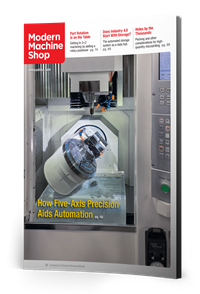What Is The Most Productive End Mill In Titanium?
Boeing experts recently responded to this question when it was submitted through our Aerospace Machining Zone
Share





Personnel from Boeing's Research & Technology group recently answered readers' questions. One reader asked the following. To see the list of experts taking questions from readers right now, see our Ask An Expert page.
Question
Welcome! You鈥檝e unlocked premium content.
We are machining a 0.423-inch diameter Ti Beta C rod into a 0.375-inch hex. We use a 6-flute carbide end mill at a feed rate of 8.7 ipm and a 0.024-inch depth of cut. No finish pass is needed. We tried an insert cutter that went 3 times as fast, but the interrupted cut tended to tear the material. Can you recommend an end mill we can use for this job that will allow a much faster feed rate than we are now getting?
Response from Boeing鈥檚 Research & Technology group
For instances where we are taking very light radial cuts (0.050 inch or less), we use either 1-inch diameter 10-flute tools or 0.75-inch diameter 8-flute solid carbide end mills for finishing titanium parts. The key with these tools is never to touch a corner. We run them at 400 sfm with a 0.003-inch chip load. We go 46 to 48 ipm when cutting with the side of the tool.
If cutting with the bottom of the tool, back off to 300 sfm but maintain the 0.003-inch chip load. When cutting with the bottom of the tool, do not ramp to depth into a part, as there is not enough chip clearance. You should either create a start spot with a different tool, or start off of the part and feed onto it. Limit axial depth of cut to 0.030 inch, but feel free to maximize your step over. Full slots are possible in this situation.
Our primary experience is with titanium 6Al-4V, so your parameters may need to be adjusted for your material. We achieve 90+ minutes of tool life with these parameters as long as our radial engagement is 0.050 inch or less and we never touch a corner. You can buy cutters such as these from Fullerton, Data Flute, Robb Jack and Onsrud, among others. The cutters are a little bit expensive, but they run really fast and in most instances we find that the extra cost is more than worth it, because they are so productive they end up saving a lot of cost in the end.
听
Related Content
-
Forkardt Hardinge Swiss Workholding Provides Reliable, Consistent Performance
The company’s Swiss collets are designed to securely hold parts without marring surfaces, minimizing vibration to ensure smoother machining, enhanced accuracy and extended tool life.
-
Shop Tour Video: Inside an Aviation & Defense Machine Shop
Grants. Software. Process consolidation. These three pillars can bring new life to a shop, enabling it to take on more complex jobs with faster turnarounds. In this shop tour, find out how MSP Manufacturing has used each pillar to solidify itself as a reliable partner for defense and aerospace companies.
-
SW North America Twin-Spindle Machining Center Enables Fully Autonomous Operation
Eastec 2025: The BA 322i is well suited for machining complex aerospace components that require tight tolerances and high-quality finishes.















